When you can't plan much, keep an open mind and an open eye.
Before touching down, we get a splendid view of Miami from above. Very impressive. An archipelago of scyscrapers.

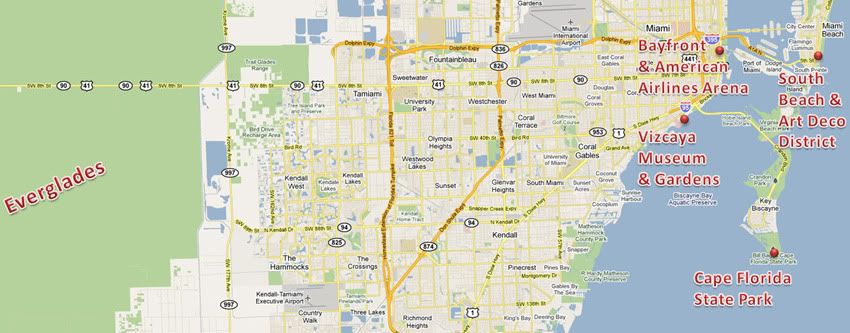
Atlanta Hawks @ Miami Heat, American Airlines Arena
I've been following the NBA for twenty years, but this is the first time I'm watching its players in their natural habitat. Rushing from the airport to the hotel and straight to American Airlines Arena, reason hasn't settled in and I'm taken aback by what I thought were Cavs fans with Lebron shirts walking bravely along Heat fans towards the Arena. Lebron now plays for Miami?! Not the sort of thing the BBC would bother mentioning.
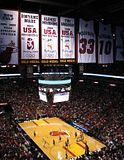 The match is unremarkable in all respects, but it serves its purpose. Plenty of opportunity to observe traditions. As we arrive outside our gate, we stop and stand still for the national anthem that has just started. I wonder about the purpose of a national anthem in a domestic game. If it is played so often, doesn't it lose a bit from its meaning?
The match is unremarkable in all respects, but it serves its purpose. Plenty of opportunity to observe traditions. As we arrive outside our gate, we stop and stand still for the national anthem that has just started. I wonder about the purpose of a national anthem in a domestic game. If it is played so often, doesn't it lose a bit from its meaning?Cheerleaders, half-court shot for a Kia, a drums show, the Heat's own DJ, a t-shirt launcher, it all feels as if the organisers try to justify the extortionate cost of the ticket with side shows.
You hear nothing racier than brief bursts of "Let's Go Heat" and the public address announcer acknowledges the better baskets of the opponents with a comically flat voice. With 82+ games a year and no opponent fans, an NBA game at the beginning of the season feels more civilised than the Ritz's tea room. A few minutes into the game and a series of amazing shots by Lebron and Dwayne remind me what it is all about; style. In the less commercialised European basketball, where winning is all that matters, players attempting such shots usually lose their job.
Back to our hotel and our ridiculously large suite. At the price of a little room in a Salisbury Bed & Breakfast, in Miami you get a 65 sq meter suite at the heart of the Financial District. Huh! Space is clearly not an issue here.
Next morning, pre-breakfast TV and my attention is caught by a televangelist, a well-dressed black man, speaking in an extremely condescending manner that seemed to irritate nobody but me! He was certain that his audience would have missed the key parts that he would be able to explain, and at times would (out of the blue) ask them to repeat a word for no apparent reason. "Whole", say it again ... "whole". And they would IMMEDIATELY and IN ONE VOICE repeat "whole". Americans are usually sceptical, very individual, and, contrary to Europeans, always ask their teacher "why". Not in this case.
Switch off TV. Going to the Everglades. Woohoo!
In the meantime, I notice that cars have no front number plates in Florida. I wonder about the implications of this.
Everglades
On the way, we listen to an audio guide. Some of the facts mentioned are pretty interesting. For example, in the early 1900s Australian melaleuca trees were introduced in the Everglades for landscaping and to help drain up the water of what was thought to be a river. At the time, it was not known that the Everglades is a large swamp itself. The melaleucas grow to immense forests in the everglades and eliminate all surrounding vegetation. They quickly started displacing native vegetation in a massive scale and the scientists tried to stop them by burning 100,000 of them. The fires themselves helped spread their seeds even futher and they grew into millions. The photo below shows the initial result of the latest effort of the scientists to use biological control.

Other facts were less interesting. 3rd largest natural park, 11th in ..., 7th in ... What's that fascination with rankings in the United States?
The Everglades are the subtropical wetlands of South Florida. Human habitation dates to about 15,000 years ago. Two major tribes eventually formed in and around the Everglades: the Calusa and the Tequesta. After coming into contact with the Spanish in the late 16th century, both declined. Another tribe, the Seminoles, made their living inside the extremely harsh Everglades after being forced there by the U.S. military during the 19th century Seminole Wars.

Most tourists visit the Everglades for the alligators and the airboat ride.

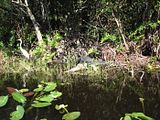

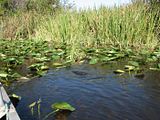
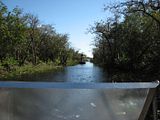

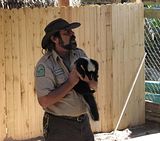
Brickell and Miami Beach (sort of)
Time to explore Miami in daytime. Feeling lucky, we take the bus for South Beach, but miss the area completely and end up outside a hospital in North Beach. I sensed that this would be only the beginning if we didn't rent a car (with satnav), but next day we bumped into a good friend from the past, who offered to drive us around the city. In the meantime, it becomes quite clear that it is not an exaggeration to call Miami a Latin American city. Out of the 360,000 inhabitants, 57% are of hispanic origin. Speaking Spanish here is much more useful than speaking English. In Little Havana, over 90% are Cubans. Expectedly, the food is heavily influenced by the Carribean. Plantains, large fried fish etc. Not bad.
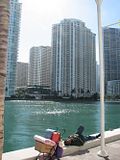
The other striking characteristic of Miami is the spectacular rich-poor divide. 25% are below the poverty level. You constantly see the homeless walking like zombies on ruins of buildings or sleeping right outside the gated island communities of the millionaires. I am told that it was worse 10 years ago. Hard to believe.
Miami gives the impression of a deserted city. Nobody is walking on the pavement. You see nothing but cars. I am told again that it's even worse in Orlando. In Miami, a number of public transport options exist, where you can meet people outside
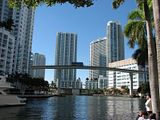 their car, but most buses and rail carriages are already or soon-to-be derelict. A very positive surprise was the MetroMover, a monorail that wiggles around the scyscrapers and over the canals offering majestic views of the city, and is free! How unusual for an American city!
their car, but most buses and rail carriages are already or soon-to-be derelict. A very positive surprise was the MetroMover, a monorail that wiggles around the scyscrapers and over the canals offering majestic views of the city, and is free! How unusual for an American city!The photos below are mainly from Brickell, where we stayed. It's the financial district. Notice the beautiful impressionistic reflection on the Bank of America's scyscraper (first photo).

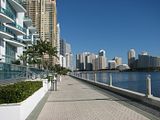
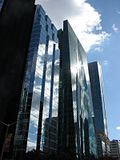



 At one of the city's canals, we saw a warning sign for manatees. We dismissed it as some sort of a joke, but another day, at a lunch break outside Hyatt Regency's canal, we were almost thrown into the water by a group of excited tourists running towards us. A 3 meter manatee was passing right below our feet. We stood still and marvelled at this beast that we had never seen before. No time to take a photo, so this one is a random one from the web. They all look the same anyway.
At one of the city's canals, we saw a warning sign for manatees. We dismissed it as some sort of a joke, but another day, at a lunch break outside Hyatt Regency's canal, we were almost thrown into the water by a group of excited tourists running towards us. A 3 meter manatee was passing right below our feet. We stood still and marvelled at this beast that we had never seen before. No time to take a photo, so this one is a random one from the web. They all look the same anyway.South Beach and Art Deco Historic District
I'm usually not interested in buildings, but I'm a big fan of Art Deco and Miami has hundreds of Art Deco hotels and apartments erected between 1923 and 1943, most in South Beach.
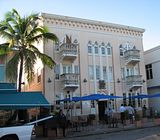
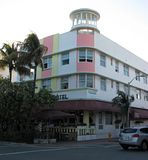
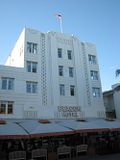
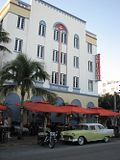
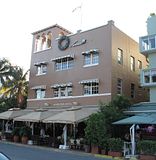
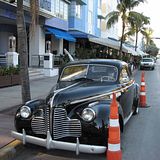


Key Biscayne
Only 15 minutes from Downtown is one of the several keys (quays in British English) that form Miami's dazzling landscape. On the way I take a photo of one of the celebrity-packed islands.

 Shells, bones and artifacts found on the island indicate a large Tequest community on Key Biscayne between 1,500 and 2,000 years ago. In 1513, Juan Ponce de León charted Key Biscayne while seeking cities of gold in the New World. He christened it Santa Marta and claimed it for the Spanish Crown. The next European was Pedro Menéndez de Avilés, who took refuge from a storm in 1565. Relations were established with the Tequesta and
Shells, bones and artifacts found on the island indicate a large Tequest community on Key Biscayne between 1,500 and 2,000 years ago. In 1513, Juan Ponce de León charted Key Biscayne while seeking cities of gold in the New World. He christened it Santa Marta and claimed it for the Spanish Crown. The next European was Pedro Menéndez de Avilés, who took refuge from a storm in 1565. Relations were established with the Tequesta and  brief missions were established. By 1763, the last of the Tequesta had left South Florida for Cuba. A story mentions that a sailor called the Viscayno had lived on the lower east coast of Florida for a while after being shipwrecked, and a 17th-century map shows a Cayo de Biscainhos, a probable origin of Key Biscayne.
brief missions were established. By 1763, the last of the Tequesta had left South Florida for Cuba. A story mentions that a sailor called the Viscayno had lived on the lower east coast of Florida for a while after being shipwrecked, and a 17th-century map shows a Cayo de Biscainhos, a probable origin of Key Biscayne.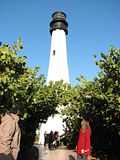 In the early 1820s several enslaved Africans and "Black Seminoles" seeking freedom from slave catchers and plantation masters, worked their way down to Cape Florida where they were offered transportation across the Gulf Stream. Some Bahamian descendants still call themselves "Black Seminoles". Florida became a U.S. territory in 1821 and the federal government built the Cape Florida lighthouse on Key Biscayne in 1825. After the lighthouse was built, Key Biscayne became less suitable as a departure point for escaping slaves.
In the early 1820s several enslaved Africans and "Black Seminoles" seeking freedom from slave catchers and plantation masters, worked their way down to Cape Florida where they were offered transportation across the Gulf Stream. Some Bahamian descendants still call themselves "Black Seminoles". Florida became a U.S. territory in 1821 and the federal government built the Cape Florida lighthouse on Key Biscayne in 1825. After the lighthouse was built, Key Biscayne became less suitable as a departure point for escaping slaves.In 1836, during the Second Seminole War, a band of Seminoles attacked the lighthouse while its keeper was away. The assistant keeper,
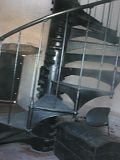 Thompson, and his African-American assistant, Carter, made it into the lighthouse tower, although Thompson had rifle balls passed through his clothes and hat, and the Seminoles had grabbed hold of the door as he was turning the key in the lock. He exchanged rifle fire from the upper windows for the rest of the day, but after dark the Seminoles were able to approach and set fire to the door. Rifle balls had penetrated tanks in the bottom of the tower which held lamp oil, and the oil caught fire from the burning door. Having taken a keg of gunpowder, balls, and a rifle with them, they were driven out of the top of the tower by the flames.
Thompson, and his African-American assistant, Carter, made it into the lighthouse tower, although Thompson had rifle balls passed through his clothes and hat, and the Seminoles had grabbed hold of the door as he was turning the key in the lock. He exchanged rifle fire from the upper windows for the rest of the day, but after dark the Seminoles were able to approach and set fire to the door. Rifle balls had penetrated tanks in the bottom of the tower which held lamp oil, and the oil caught fire from the burning door. Having taken a keg of gunpowder, balls, and a rifle with them, they were driven out of the top of the tower by the flames.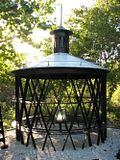 They left the lantern at the top and lied down on the 2-foot-wide platform that ran around the outside of the lantern. Thompson's clothes were burning, and both had been wounded. Certain that he was going to die and wanting it to end quickly, Thompson threw the gunpowder keg down the inside of the tower. The keg exploded, but did not topple the tower. The fire died down soon after, and Thompson then discovered that Carter had died from his wounds and from the fire.
They left the lantern at the top and lied down on the 2-foot-wide platform that ran around the outside of the lantern. Thompson's clothes were burning, and both had been wounded. Certain that he was going to die and wanting it to end quickly, Thompson threw the gunpowder keg down the inside of the tower. The keg exploded, but did not topple the tower. The fire died down soon after, and Thompson then discovered that Carter had died from his wounds and from the fire.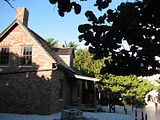 The next day Thompson saw the Seminoles looting and burning the other buildings at the lighthouse station. They probably thought that he was dead. After they left, Thompson remained trapped at the top of the tower. He had three rifle balls in each foot, and the stairway in the tower had been burned away. Later that day a United States Navy schooner that had heard the explosion came to the rescue.
The next day Thompson saw the Seminoles looting and burning the other buildings at the lighthouse station. They probably thought that he was dead. After they left, Thompson remained trapped at the top of the tower. He had three rifle balls in each foot, and the stairway in the tower had been burned away. Later that day a United States Navy schooner that had heard the explosion came to the rescue.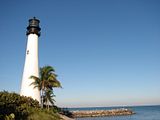 The lighthouse was repaired and put back into commission in 1847. In 1861, Confederates sabotaged it so that it could not guide Union sailors during the blockade of Confederate Florida. It was repaired and re-lit again in 1866. Today, it's the oldest standing building in Miami.
The lighthouse was repaired and put back into commission in 1847. In 1861, Confederates sabotaged it so that it could not guide Union sailors during the blockade of Confederate Florida. It was repaired and re-lit again in 1866. Today, it's the oldest standing building in Miami.
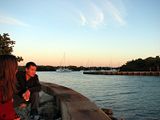
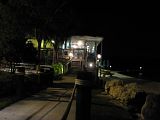

On the way back, we find a nice spot for a night photo of Miami.

The rest of the trip involved more business than leisure, and meeting old friends who were also in Miami this week. More Latin American food and a shopping mall, where I observe sharply reduced prices compared to the UK, an abundance of shoe stores and not a single bookshop.
Vizcaya
 Last day and a majestic finale with a glimpse at an American lifestyle that has vanished since. Vizcaya was built between 1914 and 1916 as the winter home of James Deering, a rich industrialist. To reach Vizcaya, you walk for about two minutes on a narrow path inside a humid subtropical forest, which is sparsely decorated with statues. Some statues look like Mayan gods, some like renaissance princes and a couple are for Ponce De Leon and Vizc... At the heart of the forest is the estate with the main building, the gardens and the dock.
Last day and a majestic finale with a glimpse at an American lifestyle that has vanished since. Vizcaya was built between 1914 and 1916 as the winter home of James Deering, a rich industrialist. To reach Vizcaya, you walk for about two minutes on a narrow path inside a humid subtropical forest, which is sparsely decorated with statues. Some statues look like Mayan gods, some like renaissance princes and a couple are for Ponce De Leon and Vizc... At the heart of the forest is the estate with the main building, the gardens and the dock.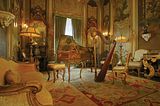 Vizcaya was designed in the style of old Italian and French estates, and adapted to the subtropical climate of Miami, which makes it look as if an Italian renaissance family has been living there today. All the decorative items were bought by Deering during his trips in Europe and include masterpieces from the 16th to the 19th century, as well as a marble table from before the destruction of Pompeii and a rug made by the moors towards their last years in Spain. Organ music would be heard throughout the house, either live or using pre-recorded rolls. At the same time, Vizcaya was
Vizcaya was designed in the style of old Italian and French estates, and adapted to the subtropical climate of Miami, which makes it look as if an Italian renaissance family has been living there today. All the decorative items were bought by Deering during his trips in Europe and include masterpieces from the 16th to the 19th century, as well as a marble table from before the destruction of Pompeii and a rug made by the moors towards their last years in Spain. Organ music would be heard throughout the house, either live or using pre-recorded rolls. At the same time, Vizcaya was 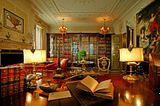 supermodern for its time, with central heating, two elevators, refrigerators, a central vacuuming system and an automatic electric telephone switchboard. After Deering's death in 1925, the house was inherited by his nieces, who didn't want to keep it. In 1952, Miami-Dade County bought it and opened it as a museum.
supermodern for its time, with central heating, two elevators, refrigerators, a central vacuuming system and an automatic electric telephone switchboard. After Deering's death in 1925, the house was inherited by his nieces, who didn't want to keep it. In 1952, Miami-Dade County bought it and opened it as a museum.Tycoons' houses are usually extravagantly cheesy. Vizcaya on the other hand is inspiring. Everything makes sense, carries its own history and is at the same time beautiful and practical.
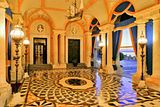

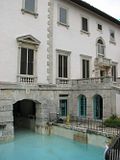

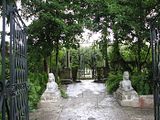



I am writing this on the plane back to London, but I need to get some sleep. I am going to work right after we touch down. Closing with a photo I took from the plane. I think it's Lake Okeechobee, the headwaters of the Everglades.
What a beautiful trip! I wish I was there... wait a minute... I was!!! lol
ReplyDeleteBack in London and I sure miss Miami's sunshine ;D
Well done for such a spontaneous trip. It might serve you better if you consider that America really is the land of Hypocrites! (Coats & Boots with Bikini's?) :D
ReplyDeleteAre these hypocrites always dressed like that? Easy to distinguish then :P.
ReplyDelete